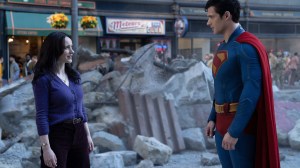Thirty years into his career, filmmaker Mark Earl Burman recently made his feature-film directorial debut with Ambush, a war film starring Jonathan Rhys Meyers and Aaron Eckhardt. The film shot in Columbia, in unforgiving conditions, and had only twenty days — which made Burman’s decades as a producer all the more valuable, as he says he was able to use his expertise on the business end of things to make the best creative decisions he could for the time and money he knew the film had. Wading through South American swamps and trying to manage sometimes up to 100 extras, it was an ambitious film — but it’s the one he wanted to put his own stamp on.
Videos by ComicBook.com
Burman said that even after all this time, movies still have not become old hat to him. The decision to step into the director’s chair wasa motivated partly because he had gained confidence after years of producing, and working on a few smaller projects as a director or co-director.
“It’s still exciting,” Burman told ComicBook.com. “On my first film, which was shot in 1993, I was 28 years old. Because I watched a lot of films, I thought I knew a lot about making films, because I’d been on a lot of sets and worked around them. About five minutes into walking on the floor on the first day, I realized I didn’t know that much. With this much experience, I knew that I was ready, that I had a particular vision for the film style. I knew that I was competent enough to make our days, keep in budget, et cetera, on the practical side. I really believe that I could bring a good, cool style and make an entertaining combat film.”
The film certainly looks bigger than its modest budget and time constraints. From its big-name stars to its sweeping combat shots — something you can get when you’re actually shooting outside — Ambush feels BIG in a way a lot of ambitious, low-budget action movies don’t.
“We had a tight budget,” Burman admitted. “We had a tight schedule. On the whole, we always made our day. But you’re basically shooting non-stop. You really get a big crew when you shoot down in Columbia. They’re the best crew I’ve ever worked with. With cast and crew, we were at almost 200 people…for this size budget. Constantly, every day, It’s either pouring rain like you’ve never seen it — or then, five minutes later, it’s a hundred degrees and a hundred-percent humidity. If I can teach any aspiring filmmaker or even seasoned filmmaker, one thing, it’s when you are in a volatile weather environment, in the outdoors, shoot in chronological order. It’s sunny, then rainy, then sunny, then rain. We had to figure out how to cut that, and it worked out. It really brought a level of authenticity to the picture.”
You would assume, too, that economical and efficient shooting is pretty important — especially when you’re dealing with big groups of extras.
“For our combat scenes, we had close to 100 people for the major scenes,” Burman explained. “You’ve got the elements you have to deal with. You have safety you have to deal with, because we had explosions. You have a lot of people out in the jungle. It definitely had its challenges. Plus, we had only 20 days to shoot this. We had very tight time constraints, and wanted to get a great look to it. We didn’t compromise on anything either. We really did not, which was very difficult because I produced it. I had to talk to myself as director and say, ‘You can have this, and you can’t have this.’ Usually, money wins. But there were times where the AD would say, ‘Well, we’ve got to move on,’ and I’d say, ‘Nope. We’re going to stick this out. I’ll figure out what to do next.’ I was lucky to have the experience to bring that silo into directing too.”
Ambush is now available on digital video on demand platforms.









